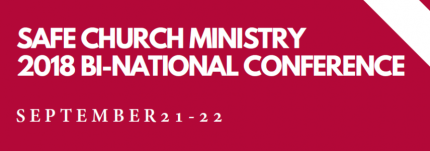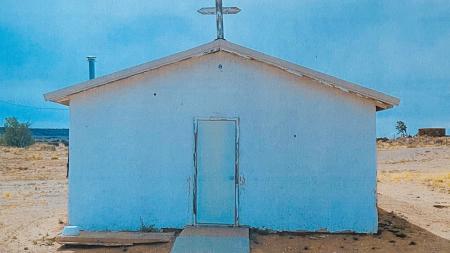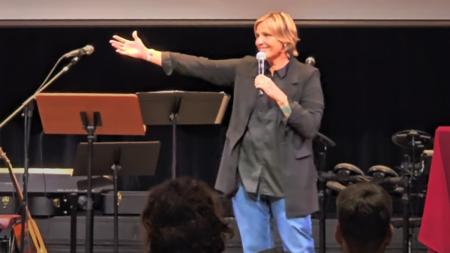#MeToo and the Christian Reformed Church

Now a hospice chaplain, Mark Hofstra was working as a summer intern at Pine Rest Christian Hospital in Grand Rapids, Mich., when he was assigned to be a member of the team working with young people who had been sexually abused.
The assignment sent shock waves through him. Until that time, he had kept a terrible secret. As a youth, he had been sexually abused by a man who was an elder at a Christian Reformed church in his neighborhood. Best to leave it buried and go on with life, he thought.
But, placed on that team, he felt God tugging at his heart, urging him to share this painful experience with someone else on the team. Once he did that, his healing, although it was very painful, began, he told a group attending the Safe Church Ministry Binational Conference last weekend.
“This man was a pedophile, and he had done this to other children,” said Hofstra. “Even though he supplied me with pornography that I wanted to see, I knew what he did to me was wrong. I knew that my innocence had been taken from me.”
Subtitled “Equipped in Our #Metoo World,” the conference drew nearly 100 participants from across the U.S. and Canada who attended workshops and heard speakers including pastors, psychologists, youth ministers, and members of safe church ministry teams in the CRC.
#MeToo / #ChurchToo Grows
Interest in this subject has grown, within and outside the CRC, as news story after news story chronicles abuse that has shattered lives, caused several people to fall from positions of power, and reminded many people of what they have been living with for years in painful silence.
Hofstra, a Reformed Church in America pastor, knows all about that silence. It helped to protect him. But once he told his story, he was relieved. At the same time, sharing his story opened him up to the emotions — the rage, the fear, the frustration — coming from the abuse.
And telling the story didn’t end the memories and lingering shame. Finally, as this process unfolded and he kept crying out to God for help, he felt God’s grace start to fill him. This gave him the courage to tell his parents what had happened, and he even tracked down and confronted the one who had abused him.
“He told me that he was brought before the elders’ board soon after he abused me and that they got him help. . . . He told me he has been delivered from who he was. . . . I extended forgiveness,” said Hofstra.
Addressing Crucial Topics
Hofstra and other speakers and seminar leaders used their own experiences, as well as their expertise, to offer conference attendees tools and information to bring back to their churches.
In doing this, they are following the lead of Synod 2018 to “lament the ongoing failure of some classes and congregations to implement safe church practices, and encourage all classes and congregations to learn from the best practices of others and to utilize the resources available through Safe Church Ministry” (Acts of Synod 2018, p. 476).
“We pray that this conference and other training events will help us to take steps forward in meeting our goal to have an active safe church team in each classis, that these teams will assist our churches to become all that God is calling us to be, and that churches will become places where the value of each person is honored and where the healing power of our Lord is free to work,” said Bonnie Nicholas, director of Safe Church Ministry.
Many issues, ranging from domestic violence to sexual brokenness in the church, and from caring for the caregiver to how digital technology affects young people, were addressed at the conference, which began on Thursday, Sept. 20, with a special invitation-only meeting for key leaders before the opening plenary session for everyone on Friday.
The event ended on Saturday, Sept. 21, with a working lunch at which attendees sat with others in their region and discussed ways for safe church ministry to move forward, considering this time in which long-held experiences of abuse, violence, and neglect are coming to light in the church and throughout the culture.
“Over the past year we have seen the #MeToo movement grow, develop, and influence the way so many view the abuse of power. We, as the church, are called to carefully listen and see how the Lord is moving to bring shalom to our world. We are also called, as the church, to actively share in God's mission as we see justice, healing, and redemption come to fruition in our communities,” said Rev. Eric Kas, Safe Church Associate.
Nicholas said the number of situations involving abuse that are reported to Safe Church has grown significantly in the past three years. For example, in the first two quarters of 2017, Safe Church responded to 28 different situations.
In 2018, in the first two quarters, Safe Church responded to 43 different situations. Now they are up to 57, more than the full tally for any previous year since they've been keeping track.
“Not all of these situations involve a church leader directly; many are situations in which church leaders contact Safe Church to discuss how to respond to a variety of abuse situations occurring in their congregations,” said Nicholas.
Working through Classis
On Saturday morning, several classis Safe Church coordinators shared their own stories of inspiration. Yvonne Lammers, Safe Church coordinator in Classis Chatham, said her classis, with the help of a small grant from Safe Church, created a short video to promote the counseling fund that has been set up for churches in the classis to help meet the needs of persons who have experienced abuse.
Barb Cole from Classis Yellowstone said she was moved to action after attending the Safe Church conference in 2016. One of the presenters there was Chris McKenna, founder of Protect Young Eyes. “The content of his speech, maintaining Internet safety with children, was so applicable to our area that I asked him if he would consider coming to Montana. To my surprise, the answer was a resounding yes,” said Cole.
Jane DeGroot, who also attended the Safe Church conference in 2016, felt the call to make her classis in Muskegon, Mich., more aware of the need to support Safe Church Ministry and the work of abuse awareness, prevention, and response among the churches in her classis.
“At the conference,” she said, “we heard stories from people who had suffered abuse, learned about abuse in general, and witnessed the healing effect of the truth being told. I returned to our church convicted to revitalize the safe church team in our church as well as in Classis Muskegon.”
Sharing Stories of Trauma
The Safe Church conference focused consistently on the reality of abuse and of the need for people who have been abused to tell their stories and for others to listen and care for them.
For instance, Andy Soper spoke on Saturday about ways to be effective in helping traumatized people. For 10 years he worked with severely traumatized youth. Among other things, he also opened the first shelter for minor victims of human trafficking in Michigan.
“Don’t judge the person you are working with,” he said. “People who have been traumatized will often behave in ways that may not make sense to most of us. Stand where they are standing. Pay attention to their pain and try to see things from their perspective.”
Hillary Scarsella, an abuse survivor, oversees a Mennonite website called Our Stories Untold and helps people write their stories of abuse by a church leader for publication on the site. Through this work, she said during the panel discussion, she has come to a deeper realization that churches will often take moral stands on issues of abuse but at the end of the day will back off in offering real help. Too often, these churches act as if they are businesses, more concerned about protecting the institution, or seeking to survive, she said.
“If the church really knew and understood what is at stake here — how much pain people carry with them — the church would do the right thing,” she said. “But we are working against such things as money and job security.”
Rev. Jay Stringer, also on the panel, spoke of being addicted to pornography as a young person despite becoming part of a group in college who studied John Calvin and other Reformed thinkers. Even as his knowledge of the Reformed faith grew, the grip porn had on him remained.
“I was still into porn and sexual fantasies,” said Stringer, an ordained CRC minister, therapist, and author of the new book Unwanted: How Sexual Brokenness Reveals Our Ways to Healing.
Over time, through the help of therapy, he began to see the reasons behind his sexual addiction and was able to begin healing only as he faced those deeper underlying issues.
Stringer’s research on over 3,800 men and women reveals the key predictors of pornography use. The primary approach the church has used to address sexual brokenness is to invite people to "stop" their lust and pursue accountability. While those paradigms are occasionally helpful to some, they are incomplete when they do not explore the unique reasons that drive people to use pornography.
In his new book Stringer aims to help people find freedom from sexual brokenness, and he suggests significant practices that people can apply in order to transform.
Such practices, said Stringer, include “choosing a wise guide or therapist” to help you on the journey to healing; leaving sexual sin by “turning your consciousness to things that bear beauty and integrity”; and forgiving yourself and others, realizing this is not a one-time process.


